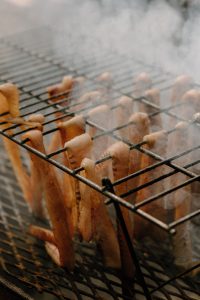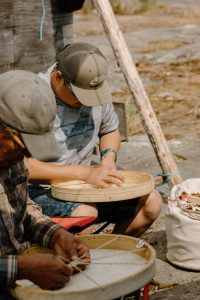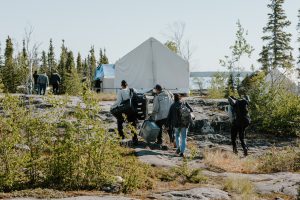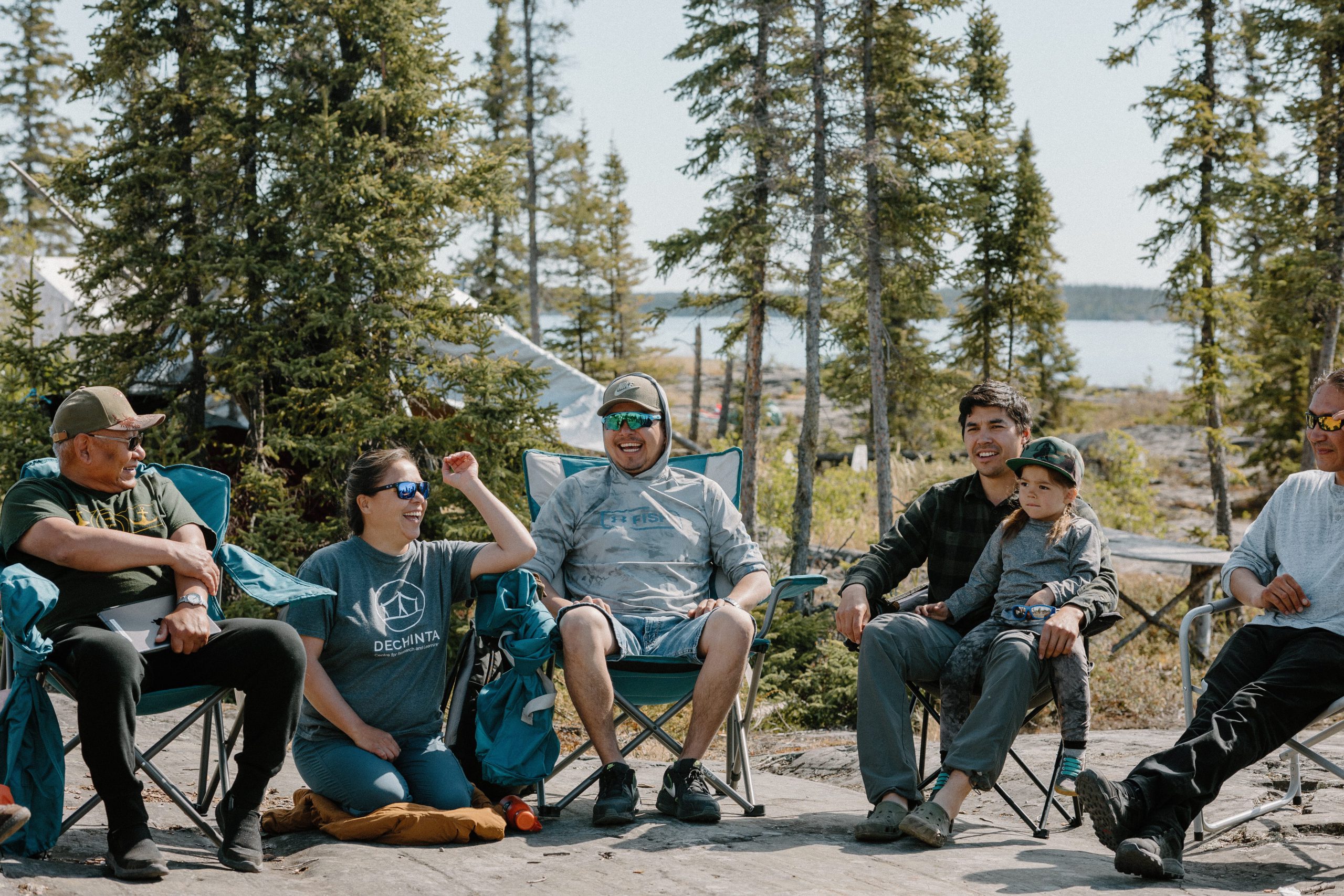The positive energy throughout the group was strong. Sounds of drums, laughter and talking, clicks of laptops and projectors coming to life, hammering, and boat engines across the calm lake water. Clanging dishes in the bustling kitchen where the next delicious meal for 25 hunters, harvesters, and guardians gathering on Mackenzie Island, about a 20-minute boat ride out of Yellowknife, on Great Slave Lake on the territories of Yellowknives Dene First Nation.
Finally, after three failed attempts over the last two years due to the pandemic, representatives from four incredible programs across the North came together in June, including: Imaryuk program led by the Inuvialuit Settlement Region – Joint Secretariat; Dechinta Centre for Research and Learning in Yellowknife; Ni hat’ni Dene Program of Lutsel K’e Dene First Nation; and Ittaq Heritage and Research Centre from Nunavut. The group stayed together on the land for four days, at the camp run by Dechinta.

Many folks from these programs were communicating with each other on the phone and zoom from at home in their communities but had never met in person. The gathering on Mackenzie Island meant that they could sit down, share a meal or a joke, and learn and share about the unique experiences in their programs across different cultures and lands. And find common ground around opportunities and barriers they face too. One of the shared barriers that was top of the list for all was how to better use evaluation tools to show the community benefit of their programs.
Sharing evaluation tools to show community benefit
 Who’s asking for evaluation?
Who’s asking for evaluation?
To be clear, it isn’t communities who are questioning the benefit and value of having hunters and harvesters out on the land bringing food and medicines back to share or acting as protective eyes and ears of the land and waters.
Yet often, funders require more quantifiable data-centric evidence that these programs have community benefit before providing or renewing their support.
Many at the gathering remarked that the amount of work it would take for funders to understand the community benefits in the way that they do, requires too much time and work, and that instead, increasing their ability to design evaluation tools that work for community AND provide some of that quantifiable data that funders request, is a preferable path forward to overcome this barrier.
A toolkit for communities
MakeWay has been working with community partners who are leading programs for hunters, harvesters, and guardians across the North for years, as part of our program priorities. These partnerships include with Ittaq in Clyde River, Nunavut, who are bringing together traditional Inuit ways of being and knowing on the land together with digital technology and cutting-edge research methods.
Ittaq began a program supporting full-time Inuit hunters to be out on the land, instructing youth and other participants, and bringing home valuable traditional foods like seal meat and distributing it within the community to Elders and others who benefit from the nutrition and cultural strength found in these foods. Then, along with researchers from SRDC, created an incredible toolkit that supports shared learning and resources for community-led hunter, harvester, guardian programs in the North.
On the second day of the gathering, teams from Ittaq and SRDC did a demo for the others of a new digital tool they’ve been working on together, that enables easy to use, visual, automatic ways to support program reporting and roll up data right from hunters using iPads, to a website that shows many things including the value of the meat that the hunter has brought back to the community, and the equivalent cost of buying that meat in the local grocery store in Clyde River.
A round of applause broke out along with big smiles, as person after person chimed in that a similar tool would be so helpful and would ease the burden of manually entering data into spreadsheets every day, to track and calculate the impact of the hunter, harvester, guardian’s activities.
“Our team was excited to learn about the work that other teams have done to create evaluation frameworks that reflect the values and needs of their communities. Harvesting is more than just a day trip—it takes generations of knowledge to know the land… to create evaluation tools that truly reflect this is incredibly difficult. Everyone left the gathering excited for the next step and committed to working together to create a toolkit that demonstrates how important these diverse programs across the North are” said Kelsey Wrightson, Executive Director at Dechina Centre for Research and Learning.
 Strengthening networks in a good way
Strengthening networks in a good way
After the demo, the teams spent time one on one with researchers, and in other small groups to talk about their current evaluation capacity and approaches, and how groups would like to add to or change a tool like this for their unique program needs. The researchers listened as groups provided guidance around what numbers or data they would like to be able to report out on for funders, and also what resources and practices do they already have in place that could feed into a digital evaluation tool.
MakeWay supported and coordinated the gathering for many reasons. “Northern communities intuitively understand that full-time land-based professions such as hunters and guardians provide numerous benefits – access to nutritious country food, mental wellness, cultural strength, environmental monitoring, job satisfaction, and so on. However, the extent of these benefits is not necessarily understood by everyone. That is why we are supporting this evaluation effort” said Steve Ellis, Program Lead, MakeWay Northern Program.
The idea presented at the gathering is that, if communities are interested, MakeWay will provide funding and supports through the SRDC team for each of the four programs to explore and build out an evaluation tool, like the one created by and for Ittaq.
Unique aspects of each program will need to be considered. For example, Ittaq’s program and tool focuses primarily on hunters and meat, whereas Iris Catholique of Lutsel K’e Dene First Nation’s Ni hat’ni Dene Program noted that incorporating plants and medicine data that works for harvesters, would be key to build in for their program.
But more than any evaluation outcome or digital tool, the gathering at the camp was a time to connect in place as communities, to enjoy fresh cooked fish and good food, talk and listen to one another in the light of the long days and warm sun, and to build the strength of an amazing emerging community-led network of hunters, harvesters, guardians across the North. This network is just part of an exciting trend of Indigenous guardian programs across Canada, helping Indigenous communities honour the responsibility to care for the lands and waters on their traditional territories.

To learn more about this work on community-led evaluation for hunter harvester guardian efforts in the North, contact steve.ellis@makeway.org. Learn more about the work and priorities of MakeWay’s Northern program.
Written by Alison Henning, Director of Communications at MakeWay of settler ancestry, who joined this gathering in June and is grateful to the participants who provided their consent for this story. All photos by Morgan Tsetta, member of Yellowknives Dene First Nation, www.morgantsettaphotography.com
